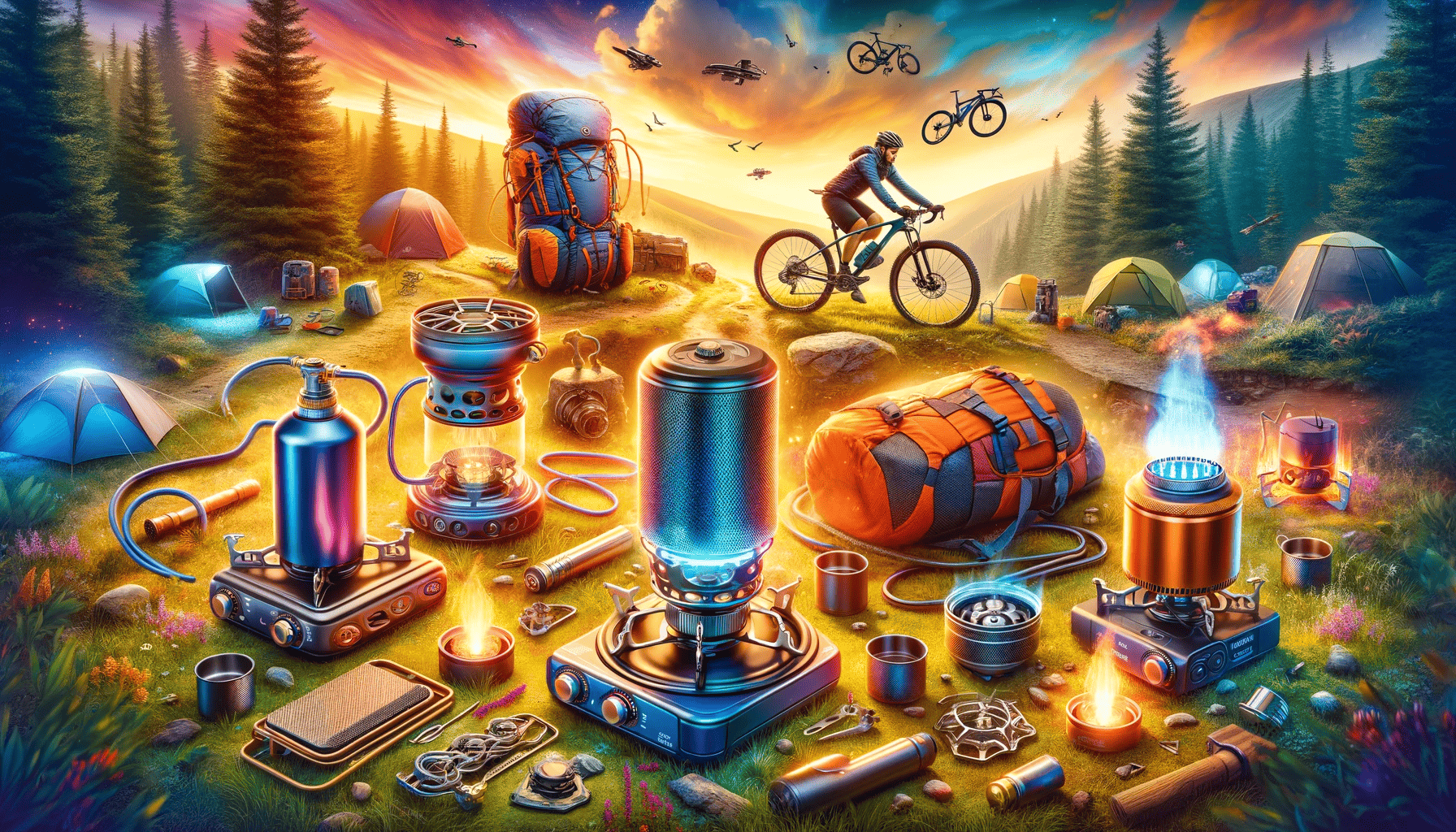You’re pedaling t ough a breathtaking landscape, the wind caressing your face and the sun kissing your skin. The air is crisp and clean, invigorating your senses as you traverse rugged trails and conquer challenging terrain.
As dusk descends, you find yourself in a secluded campsite, enveloped by the tranquility of wilderness. The scent of pine needles fills your nostrils as you set up your tent, a cozy haven amidst the vast expanse of nature.
Now, it’s time to ignite the culinary magic that will transform your campsite into a gourmet haven. Your trusty bikepacking stove, your faithful companion on this epicurean expedition, stands ready to serve as your culinary maestro.
But what makes the perfect bikepacking stove?
Is it simply about its ability to boil water? Or is there something more profound, a connection between man, machine, and the very essence of culinary artistry?
As you read on, we’ll delve into the heart of bikepacking stove selection, exploring the factors that elevate a mere cooking device into an indispensable tool for backcountry exploration. We’ll uncover the secrets to choosing a stove that not only satisfies your hunger but also fuels your spirit of adventure.
< class="wp-block-separator has-alpha-channel-opacity"/>Canister Stoves – The Portability Powerhouses
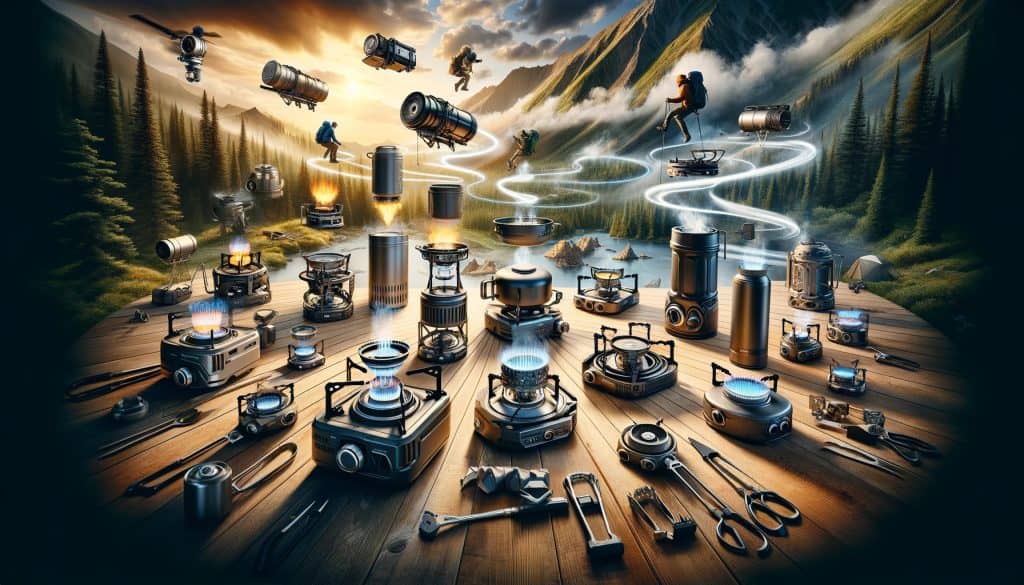
The Essence of Portability: Embracing the Convenience of Canister Stoves
Canister stoves stand as the epitome of portability, the lightweight companions for bikepackers seeking convenience and ease of use. These compact marvels seamlessly attach to fuel canisters, creating a self-contained cooking system that effortlessly packs into your pannier bags.
Unveiling the Pros: A Symphony of Advantages
Canister stoves reign supreme in the realm of portability, their lightweight construction allowing bikepackers to travel with minimal burden. Weighing in at a mere fraction of their heavier counterparts, canister stoves ensure that your bike remains agile and responsive, even on challenging terrain.
Ease of Use: A Culinary Symphony at Your Fingertips
Canister stoves are the epitome of user-friendliness, their simple operation making them ideal for even novice bikepackers. With a simple twist of the knob, you’ll have a steady flame ready to transform your campsite into a culinary haven. No more messy fuel pumps or complex priming procedures – just pure culinary convenience.
Clean Burning: A Sustainable Choice for the Environment
Canister stoves are renowned for their clean burn, emitting minimal fumes and pollutants. This eco-conscious design aligns with the values of environmentally responsible bikepackers, ensuring that their culinary adventures leave a minimal footprint on the pristine landscapes they explore.
Fuel Efficiency: Maximizing Your Backcountry Cooking Power
Canister stoves are known for their fuel efficiency, ensuring that you can savor delicious meals t oughout your bikepacking journey without worrying about running out of fuel. Their carefully engineered designs make the most of every drop of fuel, keeping your cooking adventures powered for longer.
Versatility: A Culinary Canvas for Backcountry Delights
Canister stoves are not just about boiling water; they are versatile culinary companions ready to tackle a wide range of cooking tasks. Whether you’re simmering a hearty stew, whipping up a fluffy omelet, or brewing a rejuvenating cup of coffee, canister stoves are your gateway to backcountry culinary delights.
Pros and Cons of Canister Stoves
| Pros | Cons |
|---|---|
| Lightweight and portable | Can be less powerful than liquid fuel stoves |
| Easy to use | Can be more expensive than other stove types |
| Clean burning | Fuel canisters can be bulky |
| Fuel-efficient | Not as versatile in cold weather |
drive_spreadsheetExport to Sheets
Unveiling the Cons: A Consideration of Limitations
While canister stoves excel in portability and ease of use, they do have some limitations. Their power output can be lower than liquid fuel stoves, which may not be ideal for high-altitude cooking or demanding cooking tasks. Additionally, fuel canisters can be bulky to pack, especially for extended bikepacking trips.
Fueling Your Adventures With Canister Stoves
To help you navigate the world of canister stoves, let’s look at some top-rated options…
MSR PocketRocket 2: Renowned for its lightweight design and exceptional fuel efficiency, the MSR PocketRocket 2 is a favorite among bikepackers. Its compact size and stable base make it ideal for cooking on unsteady surfaces, while its precise flame control ensures culinary precision.
Jetboil Flash: The Jetboil Flash is a game-changer for bikepackers seeking rapid cooking times. Its innovative design combines a stove and pot into a single unit, significantly reducing heat loss and boiling water in a mere 100 seconds.
Optimus Crux: The Optimus Crux is a testament to Swedish engineering, offering a balance of lightweight construction, durability, and impressive power output. Its unique cross-support design provides exceptional stability, even on uneven terrain.
Comparison Table: Top-Rated Canister Stoves
| Stove | Weight | Boil Time (1L) | Fuel Consumption | Price |
|---|---|---|---|---|
| MSR PocketRocket 2 | 2.5 oz | 3:30 min | 110 g/h | $45 |
| Jetboil Flash | 12 oz | 1:00 min | 150 g/h | $150 |
| Optimus Crux | 3.3 oz | 3:00 min | 125 g/h | $70 |
Liquid Fuel Stoves – The Unwavering Workhorses of the Outdoors

Liquid Fuel Stoves: Unleashing the Power and Versatility for Backcountry Adventures
When venturing into the wilderness, where the elements can be unpredictable and fuel resupply points scarce, liquid fuel stoves emerge as the unwavering workhorses of the outdoors.
These robust companions, fueled by a variety of liquid fuels, offer unwavering reliability and versatility, ensuring that your culinary adventures continue even in the most challenging conditions.
Unveiling the Pros: A Symphony of Strengths
Liquid fuel stoves are renowned for their unwavering power, capable of operating in a wide range of temperatures, from frigid alpine peaks to sweltering desert landscapes. Their robust construction and simple design ensure that they can withstand the rigors of backcountry travel, making them ideal for extended bikepacking expeditions.
Unleashing Versatility: A Culinary Canvas in All Conditions
Liquid fuel stoves embrace versatility, accommodating a wide range of liquid fuels, including white gas, kerosene, and even alcohol. This adaptability allows bikepackers to fuel their culinary adventures with readily available fuel sources, ensuring that their culinary prowess remains undeterred by changing environments.
Fuel Efficiency: Maximizing Your Backcountry Cooking Power
Liquid fuel stoves are the epitome of fuel efficiency, their carefully engineered designs maximizing every drop of fuel. This translates into longer cooking times and reduced fuel consumption, making them a cost-effective choice for bikepackers embarking on extended adventures.
Durability: Enduring the Rigors of the Wilderness
Liquid fuel stoves are built to last, their rugged construction ensuring that they can withstand the harshest environments. Their simple, straightforward design minimizes the risk of mechanical failures, allowing them to faithfully serve bikepackers t ough their most challenging expeditions.
Fuel Availability: A Culinary Ally in Remote Destinations
Liquid fuel stoves are not bound by the limited availability of canister fuels. Their ability to utilize various liquid fuels, including those readily found in remote destinations, ensures that your culinary adventures can continue even in far-flung corners of the world.
Pros and Cons of Liquid Fuel Stoves
| Pros | Cons |
|---|---|
| Unwavering power | Can be heavier and bulkier than canister stoves |
| Wide range of fuel options | Requires Priming which can be messy |
| Durable and reliable | Can be more expensive than canister stoves |
| Versatile for all cooking conditions | Can be tricky to start in cold weather |
Unveiling the Cons: Acknowledging Potential Limitations
While liquid fuel stoves offer exceptional power and versatility, they do come with a few considerations.
Their initial priming process can be messy and may require additional fuel, and their heavier weight and bulkier design may not be ideal for ultralight bikepacking expeditions. Additionally, starting liquid fuel stoves in cold weather can be challenging due to the reduced viscosity of the fuel.
Fueling Your Adventures: A Comprehensive Guide to Liquid Fuel Stoves
To guide your selection of a liquid fuel stove, we’ve compiled a comprehensive overview of some top-rated options, highlighting their features, specifications, and performance.
MSR Whisperlite Universal: The MSR Whisperlite Universal is a legendary stove in the outdoor community, renowned for its unwavering power, durability, and versatility. Its simple design and reliable operation make it a favorite among experienced bikepackers.
Jetboil Sol: The Jetboil Sol is a lightweight and compact option for liquid fuel stoves, offering remarkable efficiency and stability. Its integrated pot and burner design streamlines the cooking process, while its folding legs ensure compact packing.
Optimus Omnifuel II: The Optimus Omnifuel II stands as a versatile powerhouse, capable of burning a variety of liquid fuels, including white gas, kerosene, and even unleaded gasoline. Its ability to adapt to various fuel sources ensures culinary flexibility in remote locations.
Comparison Table: Top-Rated Liquid Fuel Stoves
| Stove | Weight | Boil Time (1L) | Fuel Consumption | Price |
|---|---|---|---|---|
| MSR Whisperlite Universal | 11 oz | 3:00 min | 160 g/h | $90 |
| Jetboil Sol | 9 oz | 1:30 min | 150 g/h | $165 |
| Optimus Omnifuel II | 12 oz | 2:00 min | 200 g/h | $150 |
Wood Stoves – Embracing Sustainability and Authenticity
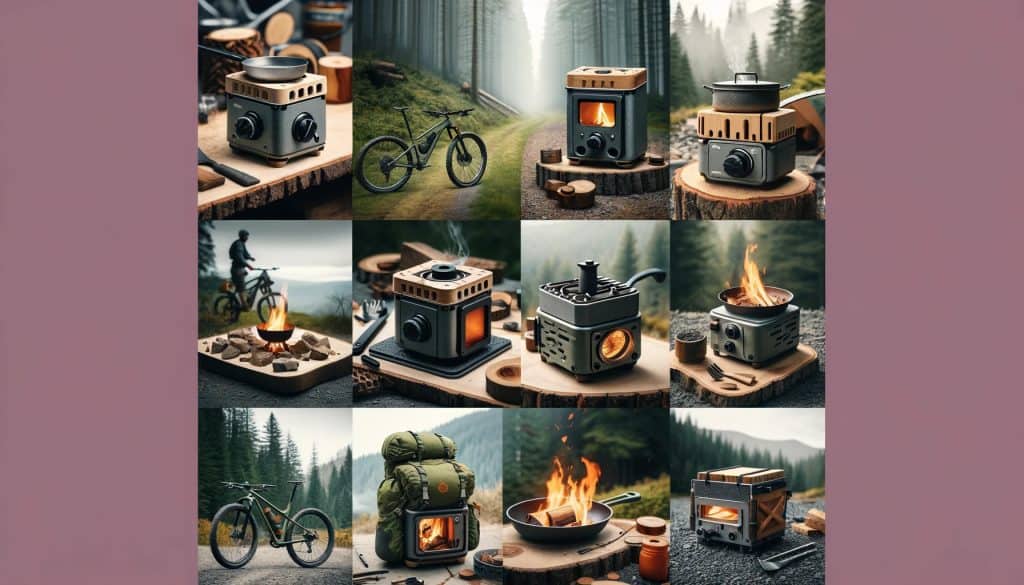
Wood Stoves: A Harmonious Blend of Sustainability, Authenticity, and Culinary Delight
In the realm of bikepacking stoves, wood stoves stand as a testament to sustainability and authenticity. These rustic companions, fueled by the very resources of the natural world, offer a unique and immersive culinary experience, connecting bikepackers with the essence of the wilderness.
Unveiling the Pros: A Symphony of Sustainability
Wood stoves are the epitome of sustainability, harnessing the boundless energy of renewable resources to fuel your backcountry culinary adventures. By utilizing readily available wood, bikepackers can reduce their reliance on fossil fuels and minimize their environmental impact, leaving a gentler footprint on the pristine landscapes they explore.
Embracing Authenticity: A Culinary Adventure in Harmony with Nature
Wood stoves offer an authentic and immersive backcountry cooking experience, harkening back to a simpler time when humans relied directly on the natural world for sustenance. The crackling fire, the aroma of burning wood, and the rustic simplicity of the cooking process create a unique ambiance that elevates the culinary experience.
Versatility: Culinary Delights Beyond Boiling Water
Wood stoves are not just for boiling water; they offer a surprising degree of versatility for backcountry cooking. With careful control of the fire, bikepackers can simmer stews, fry vegetables, and even bake bread, transforming their campsites into rustic wilderness kitchens.
Environmental Considerations: A Mindful Approach to Wood Stove Usage
While wood stoves offer a sustainable cooking option, it’s crucial to practice mindful usage to minimize environmental impact. Gather only fallen wood, avoid burning in sensitive areas, and ensure complete combustion to prevent wildfires.
Pros and Cons of Wood Stoves
| Pros | Cons |
|---|---|
| Sustainable and eco-friendly | Can be slower than other stove types |
| Free fuel source | Requires careful wood selection and preparation |
| Authentic and immersive experience | Can be sensitive to weather conditions |
| Versatility for various cooking tasks | Requires proper fire management to prevent accidents |
Unveiling the Cons: Considerations for Responsible Wood Stove Usage
While wood stoves offer a unique and sustainable cooking option, there are a few considerations to keep in mind. Wood stoves generally require more time and effort to prepare and operate compared to canister or liquid fuel stoves.
Selecting the right type of wood, properly preparing kindling, and ensuring complete combustion are essential for efficient and safe operation.
Fueling Your Adventures: A Guide to Wood Stove Usage
To ensure a safe and enjoyable experience with wood stoves, we’ve compiled a comprehensive guide outlining essential tips for wood selection, fire preparation, and cooking techniques.
Wood Selection: Opt for seasoned, dry wood that is free of sap and resin. Avoid using green or wet wood, as it burns inefficiently and produces excessive smoke.
Fire Preparation: Start by building a small, controlled fire using kindling and tinder. Gradually add larger pieces of wood as the fire establishes itself. Ensure proper ventilation to prevent smoke buildup.
Cooking Techniques: Utilize low-boil simmering techniques to conserve fuel and achieve even cooking. Use a pot stand or tripod to ensure stability and prevent heat loss.
As you embark on your bikepacking adventures, consider the unique advantages and considerations of each stove type – canister stoves, liquid fuel stoves, and wood stoves. Each offers a distinct culinary experience, catering to different preferences and environmental considerations.
Ultimately, the choice of stove depends on your individual needs, cooking style, and environmental ethos. Whether you seek the convenience of canister stoves, the versatility of liquid fuel stoves, or the sustainability of wood stoves, there’s a stove perfectly suited to elevate your backcountry culinary adventures and transform your campsites into wilderness kitchens.
< class="wp-block-separator has-alpha-channel-opacity"/>Factors to Consider When Choosing a Bikepacking Stove
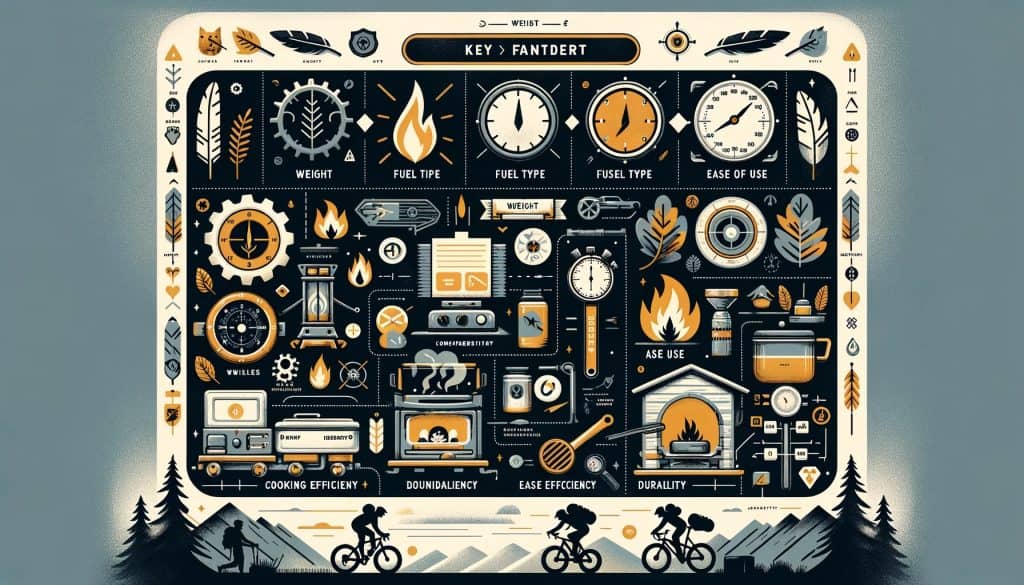
Navigating the Culinary Landscape: Choosing the Perfect Bikepacking Stove
As you embark on your bikepacking adventures, selecting the right stove is paramount to creating memorable culinary experiences in the wilderness. While the allure of wood stoves, the convenience of canister stoves, and the versatility of liquid fuel stoves may tempt your decision, a multitude of factors come into play when making an informed choice.
Weight and Packability: Minimizing the Burden on Your Bike
In the realm of bikepacking, every ounce counts. The weight and packability of your stove significantly impact the overall weight of your bike, affecting its handling and maneuverability. Prioritize a stove that strikes a balance between performance and weight, ensuring that it doesn’t overburden your bike or hinder your off-road adventures.
Fuel Efficiency: Maximizing Your Cooking Power in the Backcountry
Fuel efficiency is a crucial factor for bikepackers venturing into remote areas where fuel resupply points may be scarce. Consider stoves that maximize every drop of fuel, offering extended cooking times without requiring frequent refueling. This will not only enhance your backcountry culinary experience but also reduce the weight you carry.
Durability: A Stove that Endures the Rigors of the Wilderness
Bikepacking expeditions often take you t ough challenging terrain, exposing your gear to the elements. Choose a stove that is built to withstand the rigors of backcountry travel, with a robust construction and durable materials that can endure bumps, drops, and harsh weather conditions.
Ease of Use: A Culinary Ally that Doesn’t Slow You Down
Backcountry cooking should be a seamless experience, not a time-consuming chore. Opt for a stove that is simple to operate and maintain, even under challenging conditions. Consider factors like intuitive controls, easy priming procedures, and straightforward cleaning processes to minimize the hassle and maximize your culinary enjoyment.
Cooking Performance: A Stove that Delivers Culinary Delight
Your bikepacking stove should not only function but also deliver the cooking performance you crave. Consider factors like consistent flame control, efficient heat distribution, and the ability to handle a variety of cooking tasks, from boiling water to simmering stews and sautéing vegetables.
Key Considerations for Choosing a Bikepacking Stove
| Factor | Description |
|---|---|
| Weight and Packability | Choose a stove that balances performance with weight, ensuring it doesn’t burden your bike or hinder your off-road adventures. |
| Fuel Efficiency | Prioritize stoves that maximize every drop of fuel, offering extended cooking times without frequent refueling. |
| Durability | Select a stove that is built to withstand the rigors of backcountry travel, with robust construction and durable materials. |
| Ease of Use | Choose a stove that is simple to operate and maintain, even under challenging conditions. |
| Cooking Performance | Seek a stove that delivers consistent flame control, efficient heat distribution, and the ability to handle a variety of cooking tasks. |
Additional Considerations: Enhancing Your Backcountry Culinary Experience
Environmental Impact: Consider the environmental impact of your stove choice. Wood stoves offer a sustainable option, while canister stoves may generate waste. Evaluate your environmental ethos and choose a stove that aligns with your values.
Stove Accessories: Supplement your stove with essential accessories like pot stands, windshields, and utensils to enhance your cooking experience and protect your gear.
Safety Precautions: Always practice safety precautions when using a stove in the backcountry. Follow proper ventilation guidelines, handle fuel with care, and ensure complete combustion to prevent wildfires.
Choosing the right bikepacking stove is an investment in your culinary adventures, ensuring that your backcountry meals are not just sustenance but also a source of enjoyment and connection with the wilderness.
By carefully considering factors like weight, fuel efficiency, durability, ease of use, and cooking performance, you’ll select a stove that seamlessly integrates into your bikepacking setup, transforming your campsites into wilderness kitchens where culinary creativity knows no bounds.
< class="wp-block-separator has-alpha-channel-opacity"/>Additional Considerations – Enhancing Your Backcountry Culinary Experience
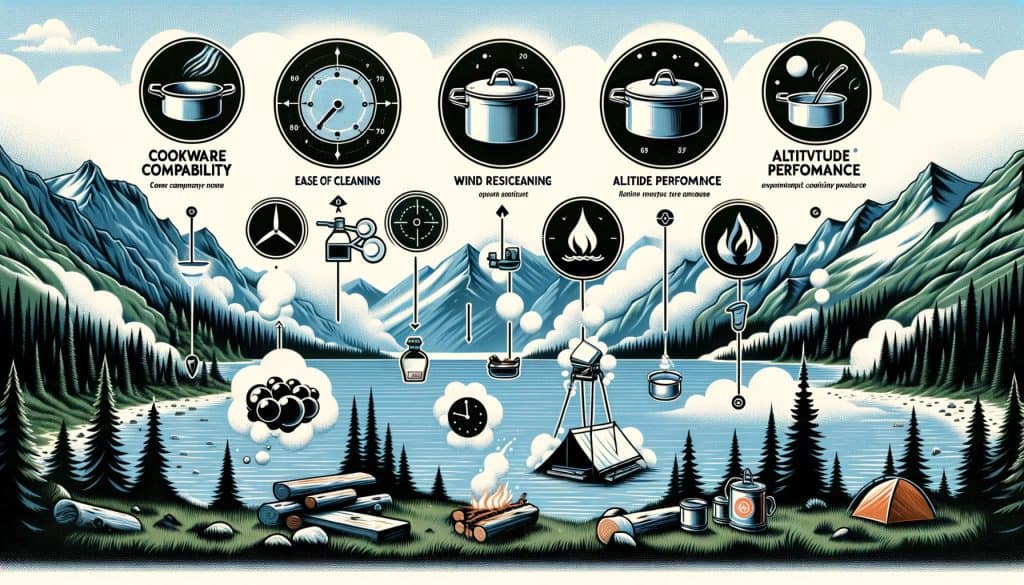
Elevating Your Backcountry Culinary Adventures: A Comprehensive Guide
As you embark on your bikepacking adventures, transforming your campsites into wilderness kitchens, consider these additional tips to elevate your backcountry culinary experiences and ensure your meals are not just sustenance but also a source of enjoyment and connection with the wilderness.
Environmental Impact: A Mindful Approach to Backcountry Cooking
While the t ill of bikepacking adventures often takes us into pristine natural environments, it’s crucial to minimize our environmental impact. When selecting a stove, consider its sustainability credentials.
Wood stoves offer an eco-friendly option, harnessing renewable resources for fuel. Canister stoves, while convenient, may generate waste, so consider their disposal responsibly.
Stove Accessories: Culinary Tools for Backcountry Efficiency
Equip yourself with essential stove accessories to enhance your cooking experience and protect your gear. A pot stand provides stability and prevents heat loss, while a windshield protects your stove from wind and conserves fuel.
Utensils specifically designed for backcountry cooking, such as lightweight and compact spoons, spatulas, and forks, ensure a more enjoyable and efficient meal preparation process.
Safety Precautions: Essential Practices for Responsible Backcountry Cooking
Safety should always be paramount when using a stove in the backcountry. Follow proper ventilation guidelines to prevent carbon monoxide buildup, especially in enclosed spaces like tents.
Handle fuel with care, avoiding spills and storing it securely to prevent leaks. Ensure complete combustion to prevent wildfires, especially in dry conditions.
Additional Considerations for Enhancing Your Backcountry Culinary Experience
| Factor | Description |
|---|---|
| Environmental Impact | Choose stoves with minimal environmental impact, such as wood stoves, and dispose of canisters responsibly. |
| Stove Accessories | Supplement your stove with essential accessories like pot stands, windshields, and backcountry-specific utensils. |
| Safety Precautions | Practice proper ventilation, handle fuel with care, and ensure complete combustion to prevent safety hazards. |
Your bikepacking stove is your faithful companion on culinary adventures in the wilderness. By carefully considering factors like stove type, fuel efficiency, durability, ease of use, and cooking performance, you’ll select the perfect stove that seamlessly integrates into your bikepacking setup.
Enhance your culinary experience with essential accessories, practice mindful environmental practices, and always prioritize safety precautions. As you transform your campsites into wilderness kitchens, let your culinary creativity flourish, savoring the flavors of the backcountry and creating memories that will last a lifetime.
< class="wp-block-separator has-alpha-channel-opacity"/>Wrapping It All Up
As your bikepacking adventures unfold, carrying the right stove is akin to having a culinary maestro by your side.
Whether you choose the portability and convenience of canister stoves, the unwavering power and versatility of liquid fuel stoves, or the sustainability and authenticity of wood stoves, each option offers a unique blend of benefits to elevate your backcountry cooking experiences.
When selecting your stove, carefully consider factors like weight, fuel efficiency, durability, ease of use, and cooking performance.
Embrace the convenience of canister stoves for quick and easy meals, harness the versatility of liquid fuel stoves for a wide range of culinary creations, or embrace the sustainability of wood stoves for an immersive backcountry cooking experience.
Enhance your culinary adventures with essential stove accessories, including a pot stand for stability, a windshield for fuel efficiency, and backcountry-specific utensils for a more enjoyable meal preparation process.
Always prioritize safety by following proper ventilation guidelines, handling fuel with care, and ensuring complete combustion to prevent hazards.
Remember, bikepacking is not just about conquering trails and reaching destinations; it’s about embracing the journey, connecting with nature, and creating memories that will last a lifetime.
Let your culinary creativity flourish as you transform your campsites into wilderness kitchens, savoring the flavors of the backcountry and indulging in the simple pleasures of cooking amidst the grandeur of nature.
